On this page, we’re discussing the fresh herbs and aromatics you’ll find in our Chinese recipes. Some of these ingredients may be familiar to you, while others might be totally foreign. Read on for the low-down on some of the most important ingredients in our arsenal!
If you’re looking for more information on other Chinese Ingredients, go to our main Chinese Ingredients Glossary page to review the different categories and easily find what you’re looking for.
SCALLIONS OR GREEN ONIONS (香葱, Xiāng cōng)
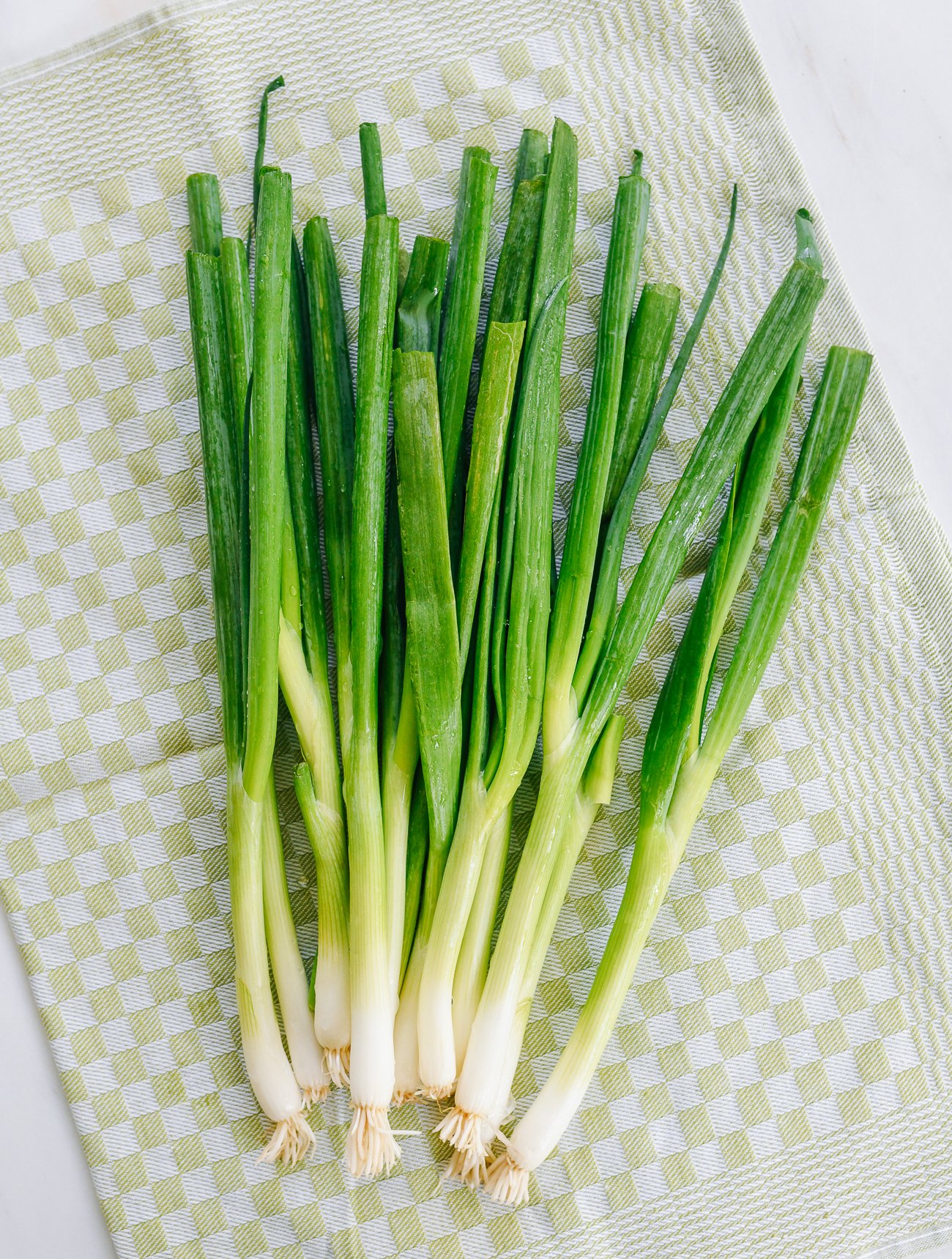
In Chinese, scallions (AKA green onions) are often simply referred to as, cōng (葱). Look for fresh, deep green scallions. Some markets store them in cold water; dry them with a kitchen towel before storing in the fridge. Note that recipes will ask you to separate the whites (which have a sweet onion flavor when cooked) and greens (great for color and garnish). Lengthwise or julienned cuts are great for steamed fish and noodle dishes, and chopped scallions are essential for fried rice and garnishes.
Large Green Onion (大葱, Dàcōng)
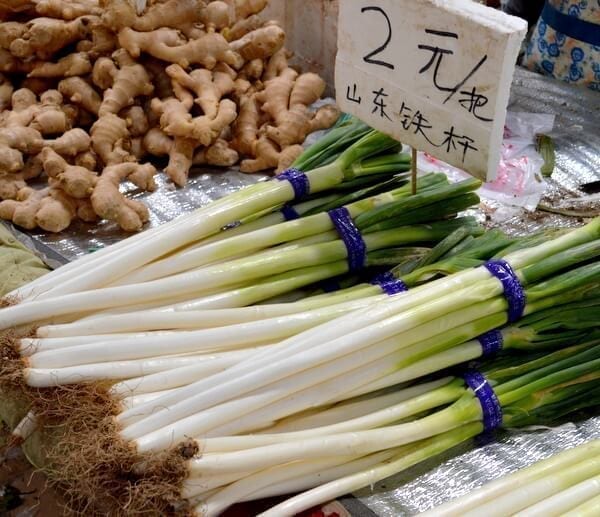
These are kind of like thick, large scallions, which a much larger white portion at the base. They look almost like leeks, but they’re more tender and definitely closer to scallions. We’ve only ever encountered these in China, using them all the time when we lived in Beijing. Scallions are a close substitute!
Leeks (韭葱, Jiǔ cōng)
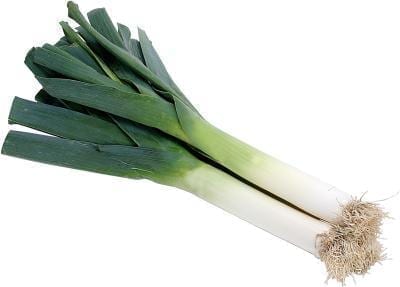
While leeks are relatively common in Western cooking, they’re a bit more rare in Chinese cuisine. That said, we do use them in our recipes—both the green portion and the white base. We use leeks in our Buddha’s Delight (Lo Han Jai) and Twice Cooked Pork.
Onion (洋葱, Yángcōng)

Yáng cōng in Chinese literally means, “foreign onion.” While they’re used in Chinese cooking here in the U.S. (including our recipes), you’ll more commonly see other alliums used in dishes in China.
Shallots (小葱, xiǎocōng)
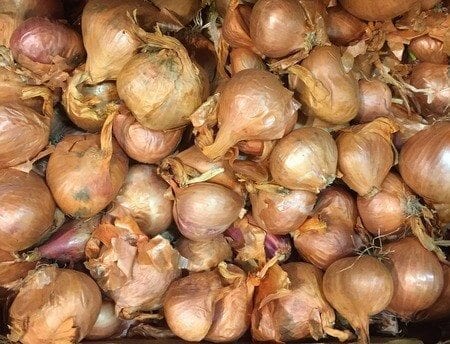
Shallots are known as xiǎo cōng (小葱 – small onion) or qīng cōng (青葱 – green onion) in Mandarin and cung tau (蔥頭) in Cantonese. So here’s one of those eternal culinary questions: why use shallots over onions? Shallots are more tender, delicate, and milder in flavor!
Garlic (大蒜, Dàsuàn)
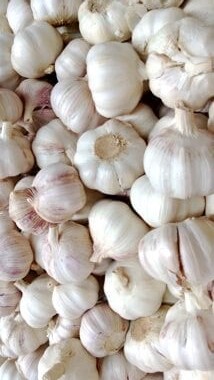
Garlic is one of those universal ingredients. It’s pronounced “dà suàn” in Mandarin and “daai syun” in Cantonese, which translates to: “big garlic.” In Cantonese, a more common name is simply “syun tao” or “garlic head” which makes a lot of sense. Even in English, we say, “get me a head of garlic.” We use garlic so often that we’re not sure what our cooking would be like without it! Thankfully, garlic’s awesomeness is a fact agreed upon by the majority of the world. We felt it deserved a spot in this glossary simply because it’s a foundation for so many of our recipes. Most of our green veggies are simply stir-fried with oil, garlic, and salt.
Garlic Greens (蒜, Suàn)
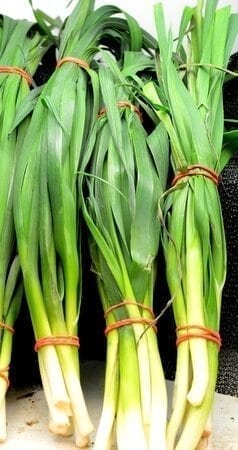
Garlic greens are generally referred to simply as suàn (蒜), pronounced in Cantonese as “syun.” Garlic greens aren’t that common of an ingredient, and may also be mistaken for scallions or leeks, but they have a uniquely pungent garlic flavor. In China, there are some signature dishes that use garlic greens. One that comes to mind is a Hunan dish cooked with preserved pork belly and garlic greens. This dish can be made with leeks or green garlic.
Garlic Scapes (大蒜花, Dàsuàn huā)
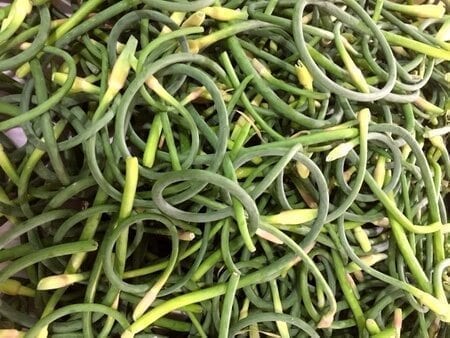
Garlic scapes are the stem and flower bud of a hardneck garlic plant. Cantonese people call them “syun sum.” They have a garlicky flavor, great for stir-frying when in season in late spring and early summer. To check the scapes for tenderness, bend them. If they snap easily, they’re tender! Try our garlic scape stir-fry.
Chinese Chives (韭菜, jiǔ cài)
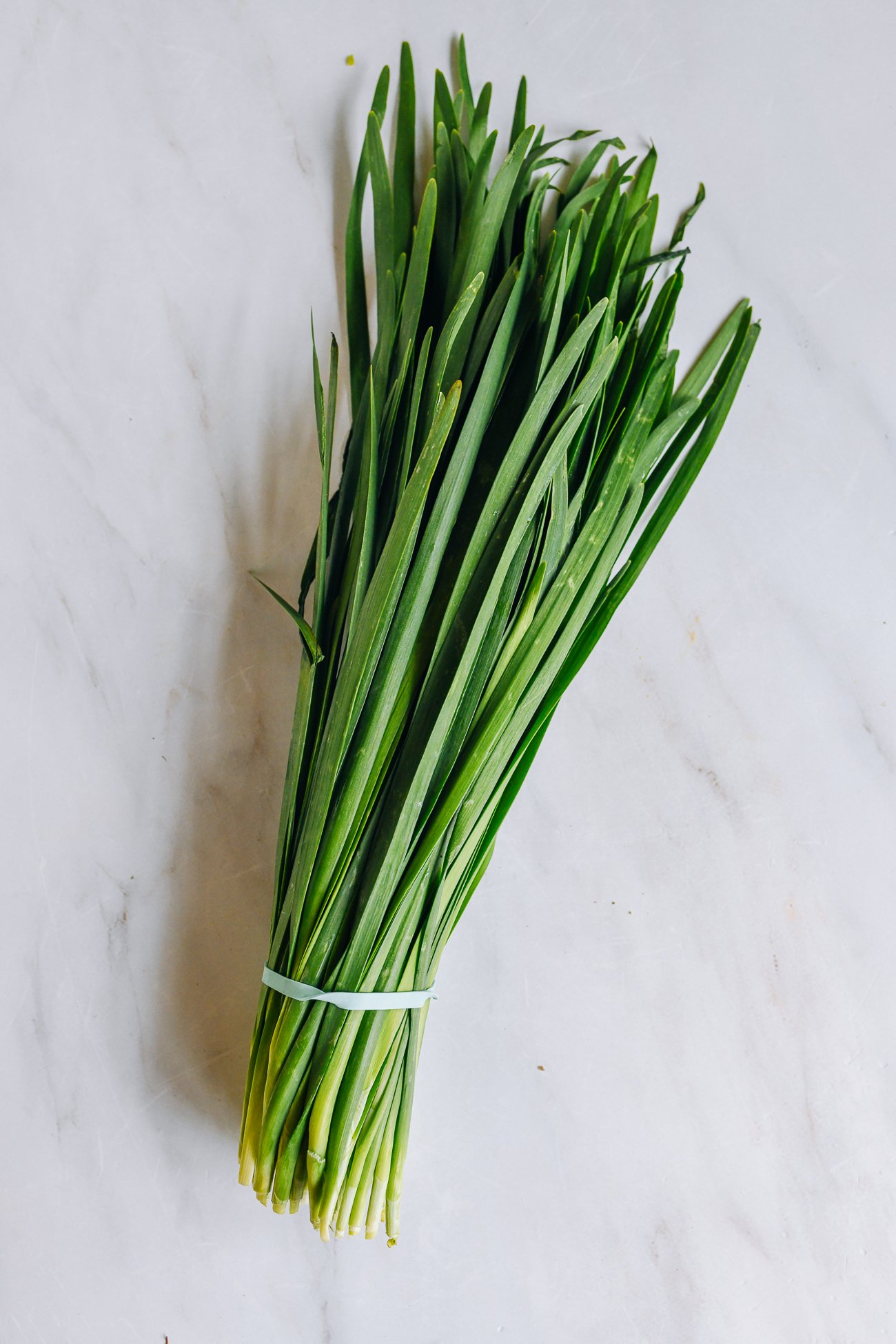
Chinese chives or 韭菜, pronounced in Mandarin as jiǔ cài and in Cantonese as “gow choy,” are recognized for their strong garlicky fragrance and meaty flat leaves. Also known as garlic chives in the western hemisphere, they are flatter and wider than regular chives. Regular chives are often eaten raw, sprinkled over the top of something, or added to sauces and dips. Chinese chives, on the other hand, are more vegetal than herbal, and we use them more as a vegetable than an herb. Learn how to grow Chinese Garlic Chives in your garden. They’re great in stir-fries and dumpling fillings!
Garlic chive stems (韭菜苔, Jiǔcài tái)
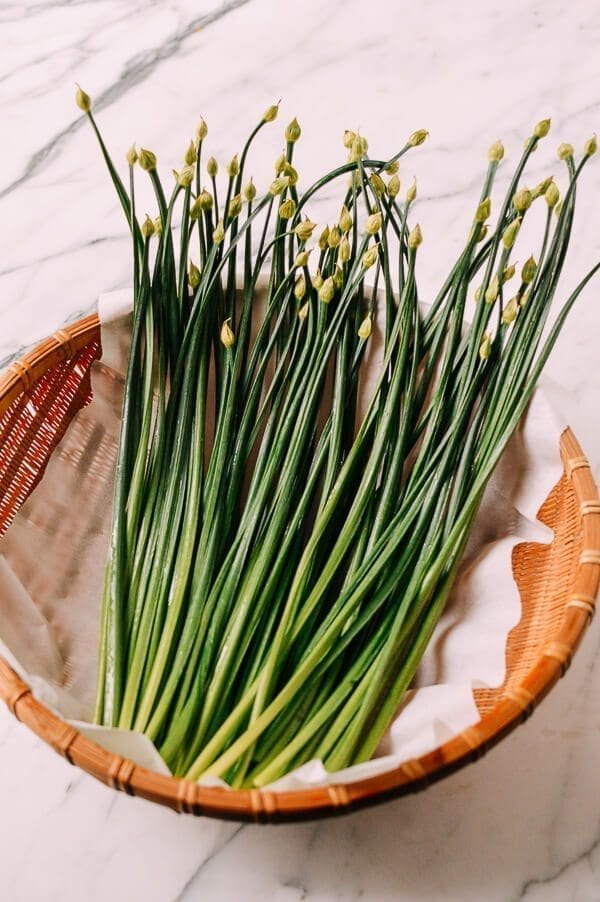
Chinese garlic chives are the leaves of the garlic chive plant. The flowering stems are also edible. Garlic chive stems sold in markets have tender, unopened flower buds, and they’re hollow, with a crunchier texture that make them ideal for stir-frying. They’re more seasonal than the garlic chive leaves, as the plant generally flowers once per season. We use them in our Cang Ying Tou or “flies head” stir-fry dish. The flower buds (and opened flowers) are edible, so don’t waste those! If you grow these yourself, you can try cooking with the flowers.
Yellow Chinese Chives (韭黄, Jiǔhuáng)
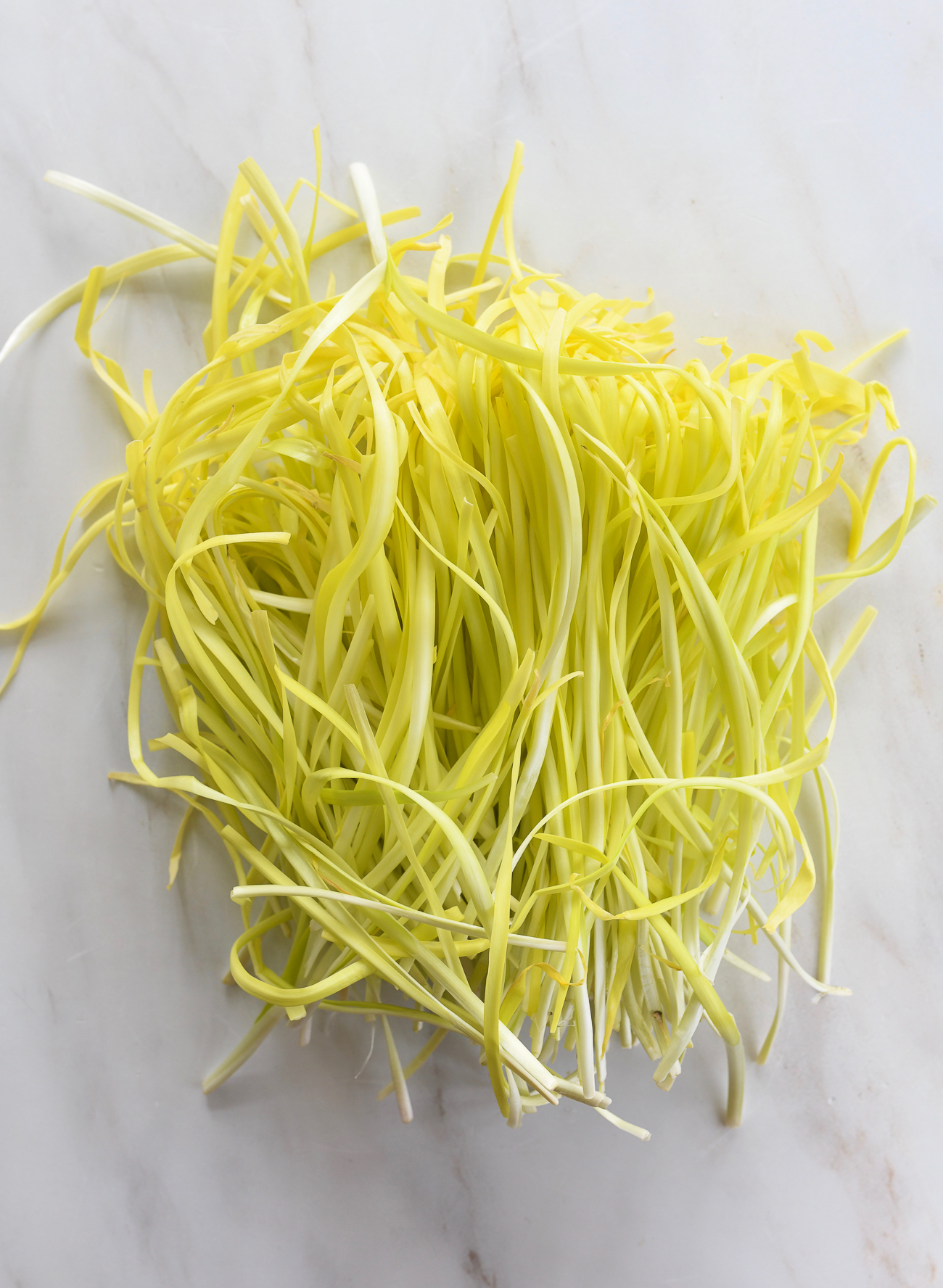
Yellow Chinese Chives are basically the same green garlic chives, but they’ve been grown with much less light, which causes a lack of green pigment (chlorophyll). In Cantonese, it’s called “gow wang,” and the ingredient is often used in Cantonese noodle and seafood dishes. Yellow chives have the same basic flavor as green garlic chives, but with a milder delicate flavor, which is characteristic of Cantonese cooking. These tend to be more expensive than regular garlic chives.
Ginger (姜, Jiāng)
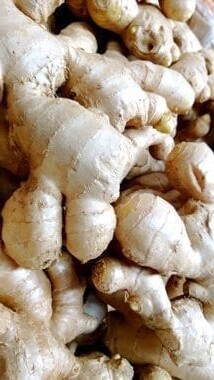
Ginger is used extensively in Chinese cooking, pronounced “geeong” in Cantonese. We have quite a few dishes that use ginger, many of which involve seafood, since the flavor pairs well with shellfish and fish (try our Cantonese Steamed Fish and Ginger Scallion Lobster). You can find ginger easily in your local grocery store, but it is highly likely that it will be cheaper, fresher, and more abundant at an ethnic grocery store. Chinese or Indian groceries are good bets, as these two cuisines use a lot of ginger. If you don’t use ginger often, peel it when you bring it home from the store, slice it, and then freeze it in a resealable bag for whenever you need it.
Galangal (高良姜, Gāoliáng jiāng)
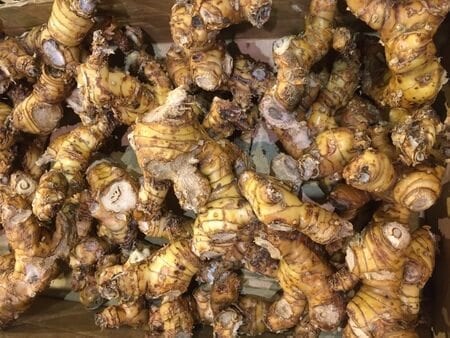
Galangal resembles ginger, but it has a citrus-y and pine-y flavor. You’ll see it most often in Southeast Asian cooking. Fresh galangal is hard to come by in the U.S., even in Asian markets (unless you can find one that specializes in Southeast Asian ingredients), but you might find it in the freezer section!
Fresh Turmeric (姜黄, jiānghuáng)
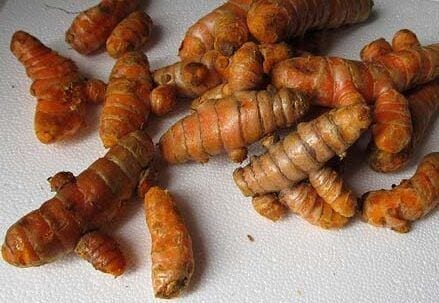
You may be familiar with turmeric in its dried, powdered form. Although we haven’t published any recipes using turmeric in its fresh form, we do use turmeric powder in our recipes. It’s definitely time to expand our horizons and get some fresh turmeric into our kitchen!
Cilantro / Coriander (香菜, Xiāngcài)
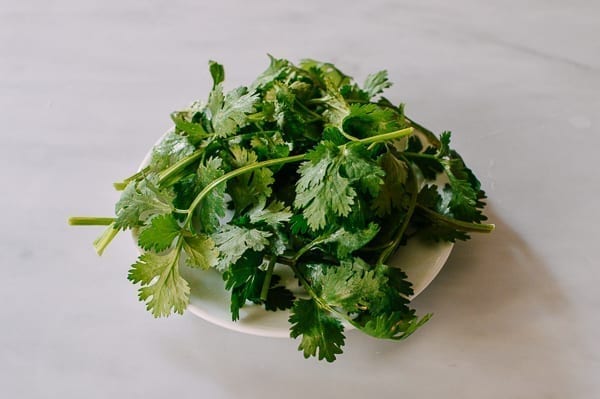
Pronounced “heung choy” in Cantonese, cilantro (AKA coriander) is an essential ingredient in Chinese cooking—whether you love it or hate it! We use it as a garnish, in sauces and dressings, and in soups.
Thai Basil (九層塔, jiǔ céng tǎ)
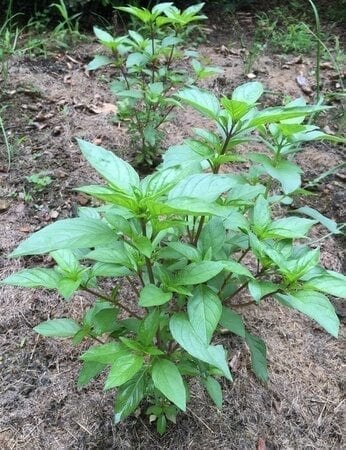
You can find Thai basil, also known as cinnamon basil, in Chinese and Southeast Asian groceries—or you can grow it yourself in the garden! (Yep, those beauties in the picture are 100% homegrown!) There are many varieties of basil that are similar to Thai basil, but the kind we use most often is the variety that has purple stems and flowers. Some examples of dishes that use this fragrant herb: Thai Basil Shrimp Fried Rice, Thai Basil Beef, and Thai Basil Pork Belly.
Holy Basil
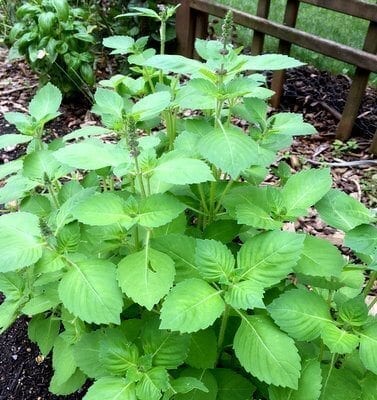
Holy basil is hard to find, even in Asian groceries. It’s quite different in flavor from Thai basil, with more of an anise or licorice-like character. The leaves are also broader than those of Thai basil, with jagged edges, and the stems are green rather than purple. Recipes like our Thai basil beef and Thai basil chicken are traditionally made with holy basil, but Thai basil can work as a substitute!
Lemongrass (香茅, Xiāng máo)
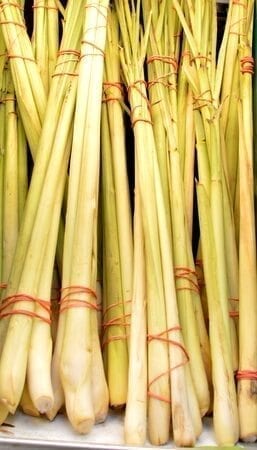
Lemongrass is a commonly used ingredient in Southeast Asia, but it has spread throughout the world due to its fragrant and fresh flavor. What we didn’t know about lemongrass is that certain varieties are used to make citronella for mosquito repellents! Indeed, it is also known as citronella grass. To use lemongrass, you must first remove the tough outer layers (anything that feels particularly tough and papery). You can also trim off the top several inches, which are also tough. Freeze any that you don’t use for later! Try lemongrass in our Roasted Lemongrass Chicken and Spicy Vietnamese Beef Stew.
Makrut Lime leaves
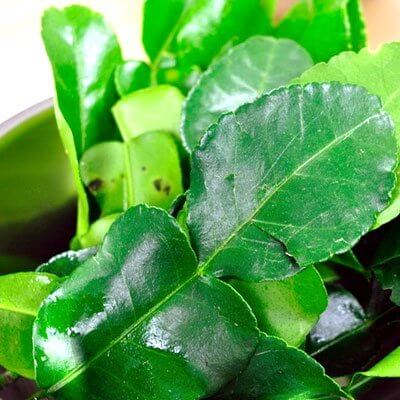
Makrut Limes are bumpy-skinned limes coveted for their fragrant leaves that enhance Southeast Asian soups and curries. You may know it as kaffir lime, but it’s come to our attention that the word “kaffir” is an offensive term to some. We usually find these leaves either in the freezer section or dried, but you might be lucky enough to find fresh leaves at Southeast Asian specialty grocers.
Curry Leaves
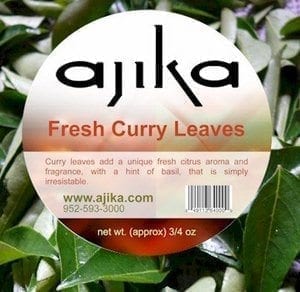
Curry leaves are an awesome herb that we love in Indian dishes. You may be able to find them fresh in Indian grocery stores. You may also see them in dried form. We rarely use them in our own cooking, but we wanted to include them here to be comprehensive!
Chinese Toon Sprouts (香椿, Xiāngchūn)
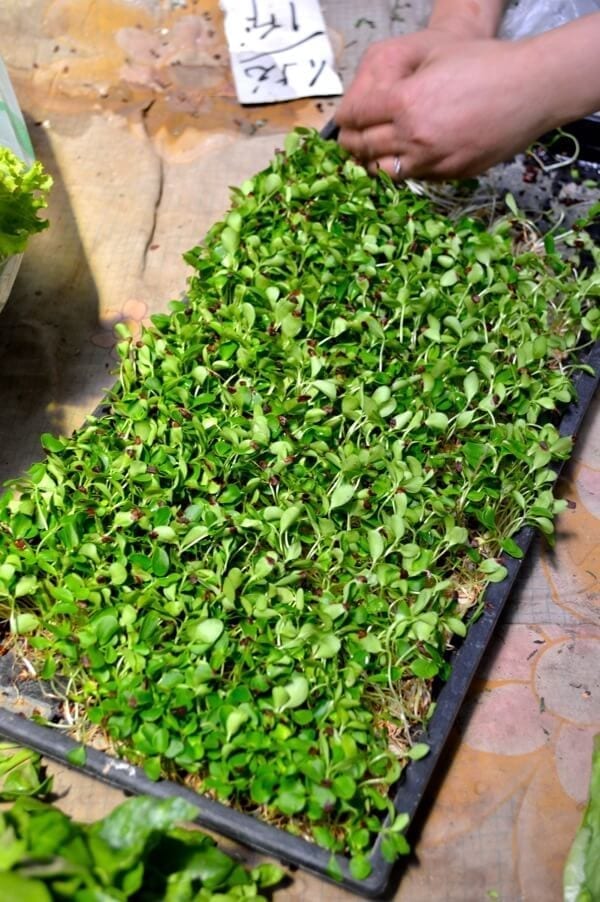
This is an aromatic that is generally only available in China in the springtime. Young toon leaves are harvested from Chinese cedar or Chinese mahogany (toona sinensis), a deciduous perennial tree. The leaves have a purple tint with a floral, peppery, aromatic onion-like flavor that’s hard to describe. They are sold as both sprouts and leaves. We had never eaten toon leaves or sprouts prior to our temporary move to Beijing, but they really enhance the flavor of cold tofu appetizers, salads, and egg dishes, like our Stir-fried Shrimp and Eggs.
Mugwort (艾草, ài cǎo)
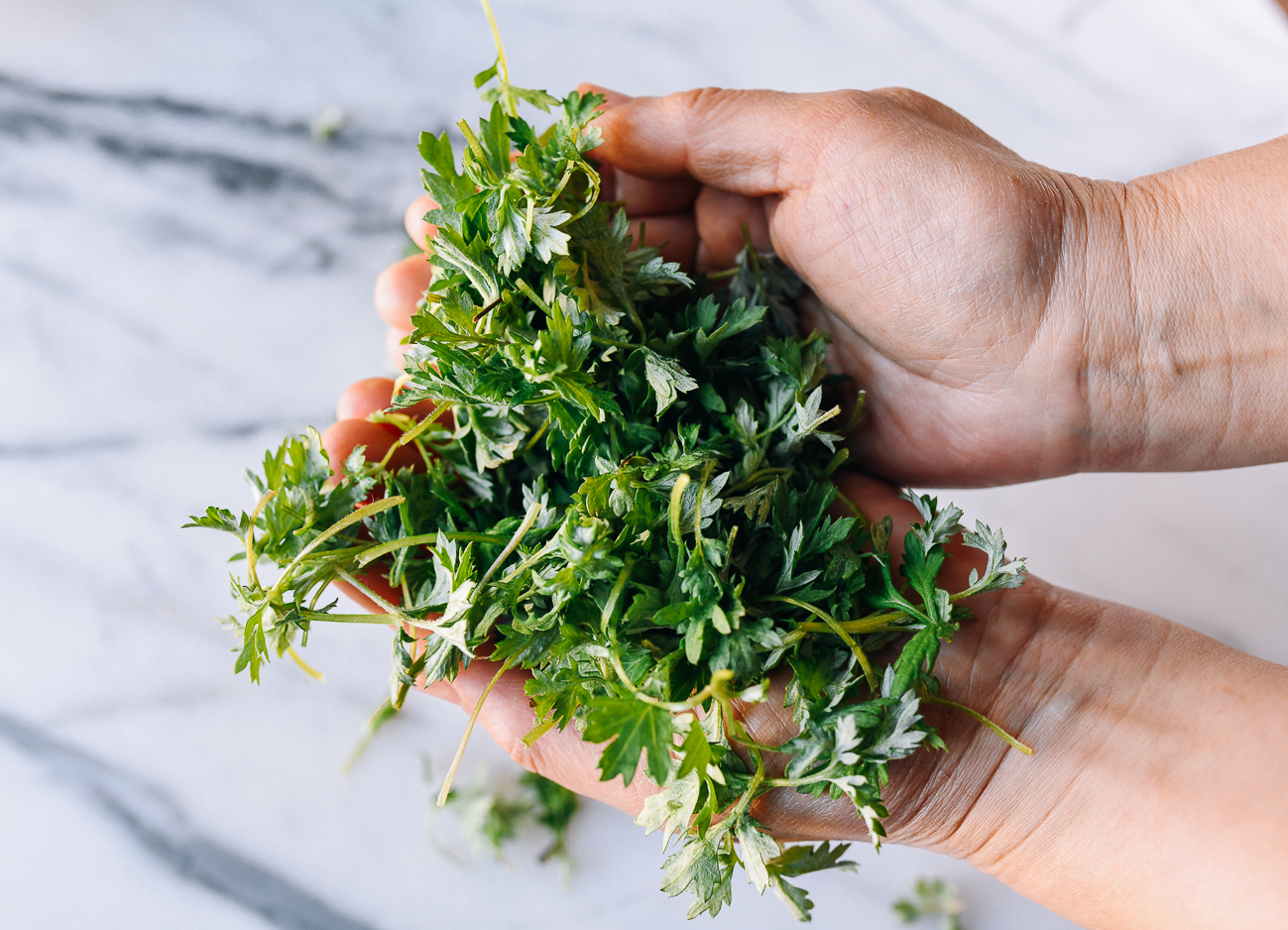
Mugwort (artemisia vulgaris), also known in English as wormwood, grows as a weed (you may be able to find it growing where you are—we have tons of it on our property), but it’s actually used in Traditional Chinese Medicine and our Qing Tuan (Mugwort Mochi) Recipe.
Long Hot Green Peppers (牛角椒, Niújiǎo jiāo)
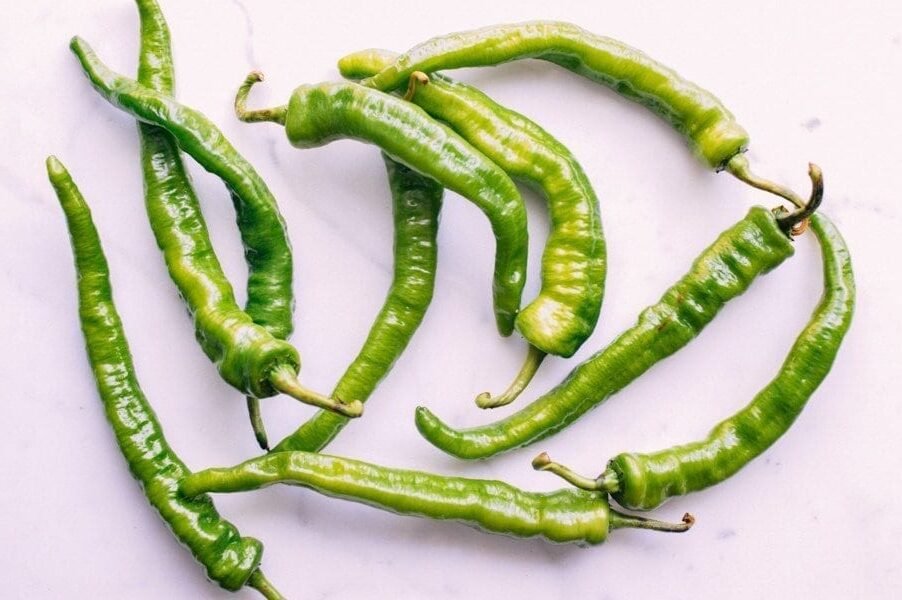
In China, long, thin-skinned, spicy green peppers are common in stir-fries. They’re called cowhorn peppers, but there are several varieties more widely available here in the U.S. The type that we buy from Chinese markets and even regular grocery stores are known as Italian Long Hot Peppers, or sometimes “Italian Sweet Chili Peppers.”
The only downside is that the heat index of these peppers varies greatly. Sometimes they’re mild, and sometimes they can unleash an unsuspected sweat storm during meals. If you can’t handle too much spice, try substituting Anaheim or Cubanelle peppers, which have a similarly thin skin and crisp texture. Check out our recipes for Tiger Skin Peppers, Beef and Pepper Stir-fry, and Sichuan Three Pepper Chicken!
Thai Chili Peppers
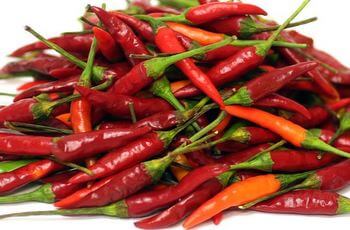
The Thai chili pepper, also called Bird’s Eye Chili, is a very small, very spicy chili used to add heat in Thai and other Asian recipes. You can de-seed them to reduce some of the heat before adding them to stir-fry and noodles dishes, or keep them whole as a garnish. If we can’t find these peppers or want a little less heat, we will often use larger red holland chilies (below).
Red Holland Chilies
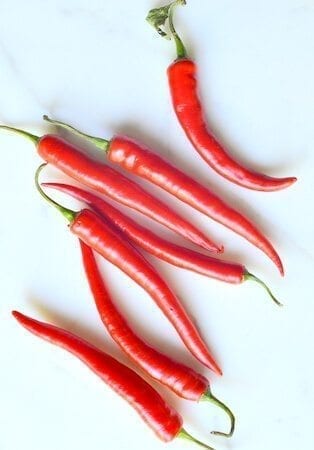
We stumbled upon Holland chili peppers while shopping at our local Asian store. They are relatively inexpensive and have a good balance of mildness and heat. They’re spicy enough to kick you in the pants a little, but not so spicy that you feel the need to chug a gallon of milk. That being said, the world of chili peppers is vast, and we’re always looking for new ways to add a bit of spice to our dishes. We’d love to hear about your personal chili preferences and experiences! Leave a comment below!
Shishito Peppers
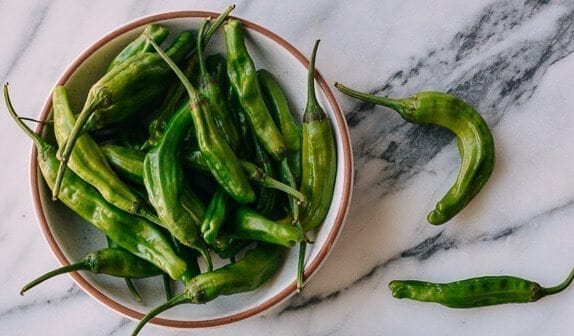
Shishito peppers are small, tender green chilies that are generally sweet (but every 1 out of 10 peppers can be wildly spicy, so look out when you eat these)! Growing in popularity, Shishito peppers are becoming more widely available in supermarkets. Like Spanish Padrón peppers, blistered or seared Shishito peppers are quite the popular dish!
our hand-picked pantry essentials—in one place!
We worked with Pearl River Mart, a family-owned Manhattan Chinatown institution in business since 1971, to collect our hand-picked pantry essentials (and some extras!) into this incredible Pantry Essential Friendship Box. These are the ingredients we use in our own kitchen. Get it shipped directly to you, and start cooking!
Get The Woks of Life x Pearl River Mart Pantry Essentials Friendship Box!
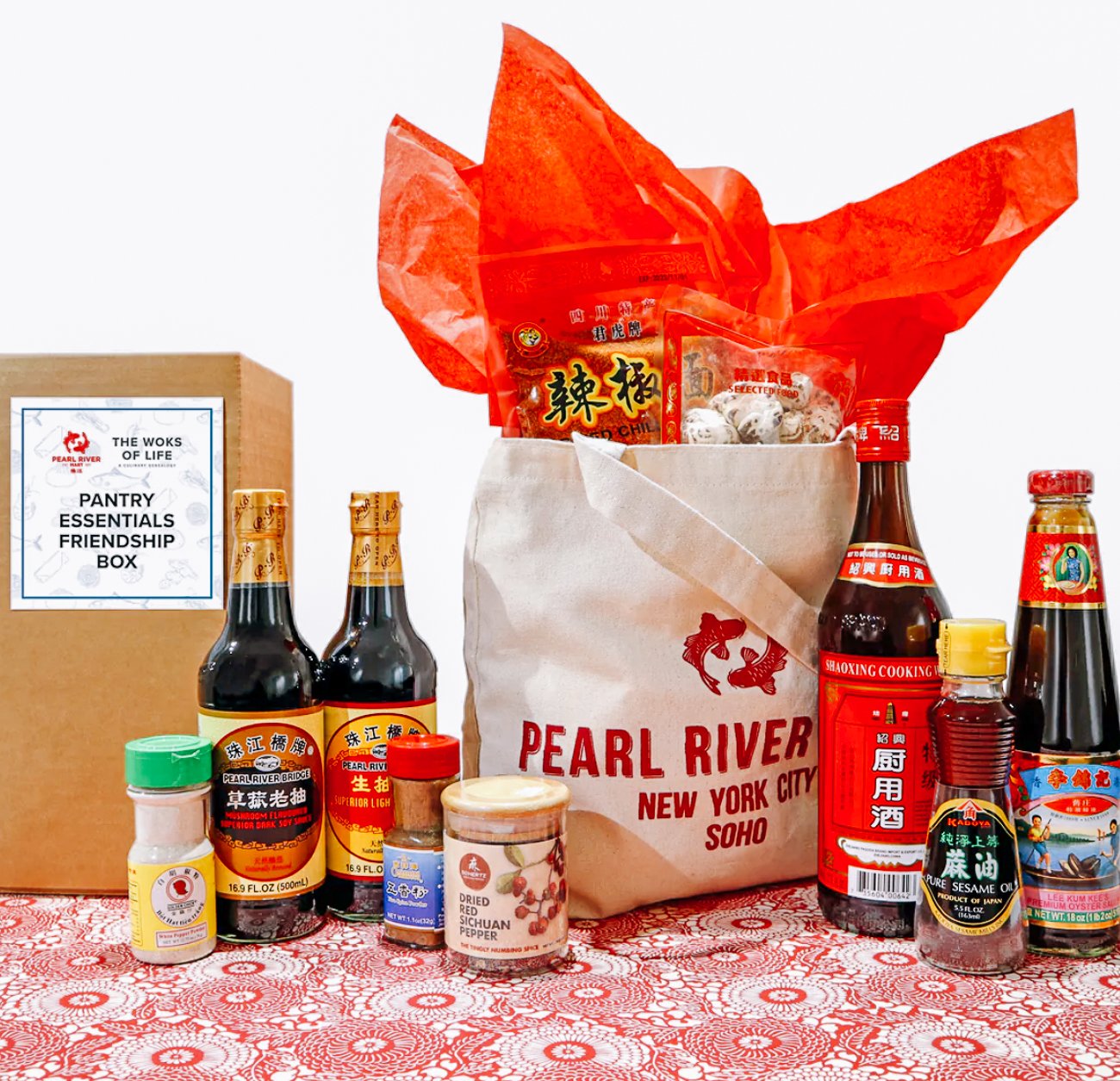
Wrap it up along with a copy of our cookbook for a unique wedding/wedding shower, holiday, birthday, or anytime gift! If you want to beef up the gift basket even more, Pearl River Mart sells woks, wok spatulas, and a plethora of other Chinese kitchen equipment! Check out our Chinese cooking tools page for ideas.